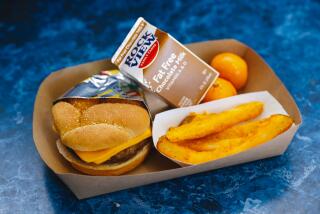Packing Nutrition Into Lunch : There Are Tasty Ways to Get Kids to Eat--and Eat Right--Even When You’re Not Watching Them
- Share via
Ask dietitian Susan Magrann about packed-lunch horror stories, and she’ll answer with two unthinkable words: chocolate sandwich.
A few years ago the nutrition coordinator for the Orange County Department of Education was randomly surveying school lunches when she came upon a Hershey bar between two slices of bread.
It’s an extreme example, Magrann said, that illustrates the danger of unsupervised lunch packing.
“You can let your kids make their own lunches, but make sure you look at what they’ve done,” Magrann said. “I couldn’t believe this kid packed a chocolate sandwich.”
As summer winds down and students are fretting about what clothes, backpacks and accessories to put on their outsides, nutritionists suggest that more attention be paid to what goes inside.
With creativity and variety, experts say, parents and children can work together on lunches that won’t get chucked for vending machine sweets or traded for Twinkies.
“It’s hard to do a lunch that’s creative for kids. They get bored easily,” said Sandy Landry, who heads the county Department of Education’s Health and Wellness program. “But if you get kids involved in the process and be original, you can have a lot of fun with it. Instead of using bread every day, make a sandwich with lettuce leaves.”
The In Crowd
Nutritionists agree on aspects of kid appeal: Cut and sliced food is better than whole, and smaller portions are better than large ones.
“It’s really important to have finger foods, things they can munch on,” said Theresa Grumet, a registered dietitian with Newport Center Medical Group in Newport Beach. “One of the things I suggest is a nut and dried fruit and cereal mixture; it has a lot of fiber, is low in fat and healthy.
“Maybe put peanut butter on a graham cracker in lieu of a cookie, or give them popcorn or a flavored rice cake--they’re low fat, high fiber and fun for kids.”
Peanut butter is a good source of protein, Grumet said, but standard brands should be avoided.
“I would promote old-fashioned peanut butter, like Laura Scudder’s or Trader Joe’s,” she said. “They have fat but not the hydrogenated, bad fat.”
Magrann said an ideal lunch “would be one with protein in it, such as peanut butter, lunch meat, low-fat cheese, tuna, bean sprouts or cottage cheese in a thermos.”
Protein will tide kids over longer, she said. The meal should be rounded out with complex carbohydrates, such as bread or crackers (some very interesting lower-fat crackers are available), and fruits and vegetables.
Those are the essential lunch ingredients, though experts concede that getting kids to eat vegetables can be tough.
“Crunchy vegetables, like carrot sticks or celery, can be quite tasty in a dip,” Grumet said. Consider low-fat ranch dressing, bean dip or salsa.
Including something sweet is important too, Grumet said, “because otherwise they’ll just crave it more.” She advises making the portion small enough so it won’t ruin a child’s appetite if--probably when--he or she eats it first.
Cutting and slicing make a difference.
“We’ve found that if we serve a whole piece of fruit they won’t eat it, but if we serve a half piece or sliced fruit they will eat it,” Landry said. “I’d rather they split it up and give them half an orange or half a banana, and then at least they’ll eat the half.”
Nothing Doing
As important as what to put in a lunch, experts said, is what to keep out of it. Though not as bad as the chocolate sandwich, nothing raises the ire of dietitians like Lunchables and other prepackaged snack packs from the deli case.
Though popular among schoolchildren, they are “extremely high in salt, not very nutritious and cost about three times as much as what you can do on your own,” Magrann said.
Children do seem to like the separate sections, so Magrann suggests small portions in small bags for the same result, separating crackers, cheese and ham or turkey.
“Ziplock makes a small snack bag, and we’ve found that little things in little bags will perk kids’ interest,” she said.
When it comes to drinks, most experts advise purchasing milk or juice at school. A frozen juice box is a good way to keep other items cold until lunchtime, but parents should read juice labels carefully, Grumet said.
“You have to make sure it’s 100% juice and not a juice drink with 90% sugar,” she said.
Reading labels, Grumet said, is important with all foods, especially those with a “fat-free” label.
“A lot of times they put in twice the sugars to make up for not having the fat,” she said. “Canned soups and pastas are extremely high in sodium and often not very nutritious.”
Experts agree that for food, just as in other aspects of raising a child, communication is important.
“Talk to your child about what they really do eat rather than just giving them stuff,” said Margo Stone, longtime head nurse in the Tustin Unified School District. “Let them have choices, and let them know what their parents expect.”
(BEGIN TEXT OF INFOBOX / INFOGRAPHIC)
Lunch-Box Biggies
Fast-food takeout may be most youngsters’ first lunch choice, but it may not be the most practical or nutritious. Here’s a list of what children say they’d like to find in their lunches--and some healthful choices that parents say are popular:
What Kids Say They Want
Fast-food burritos
Fast-food burgers
Pizza
Pizza kit
Chocolate-wafer and chocolate-chip cookies
Pressed fruit snacks
Potato chips, corn chips
Bananas
Watermelon slice
Oranges
Turkey sandwich
Peanut-butter-and-jelly sandwich
What Savvy Parents Pack
Sliced fresh vegetables with cream cheese
Puffed-rice cereal bars
Rice cakes
Pretzels
Carrot sticks
Grapes
String cheese
Juice boxes
Nuts with raisins or other dried fruit
Fruit-flavored gelatin, pudding cups
Sliced salami, bologna
Muffins
Healthy Choices
Here’s what experts say a wholesome school lunch should include:
* Protein
Ppeanut butter, lunch meat, cheese, tuna or cottage cheese
* Complex carbohydrates
Bread, crackers or cereal
* Fruit
Apple, pear, plum, orange, grapes, banana, raisins or dates
* Vegetables
Carrots and celery sticks


